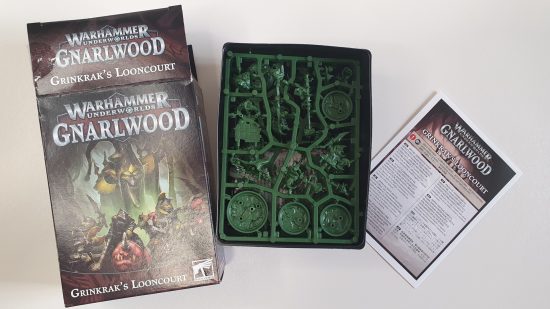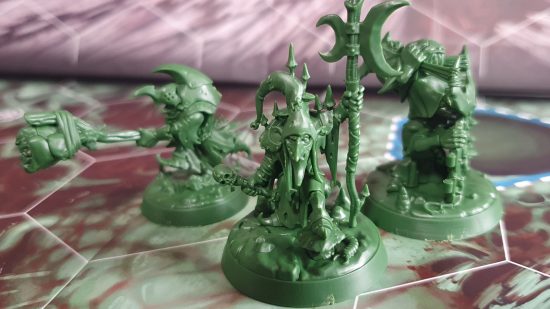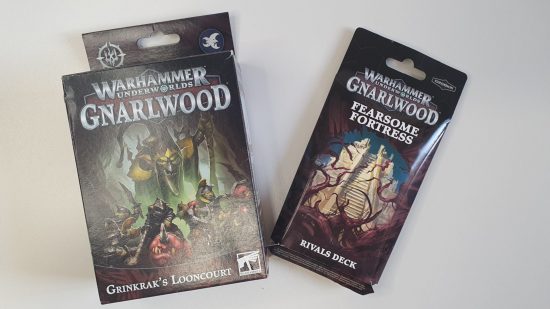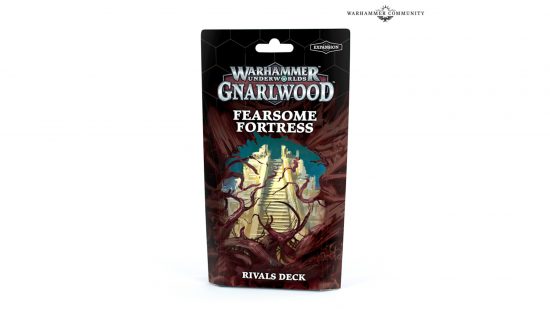Our Verdict
With great models and a great theme that shines through in the mechanics of their Rivals deck, Grinkrak’s Looncourt are easy to recommend straight out of the box. Theme-specific mechanics in their cards support the narrative and are great fun, but make deck-building more challenging.
Grinkrak’s Looncourt is the first warband expansion for Warhammer Underworlds’ Gnarlwood season, released alongside the Fearsome Fortress Universal Rivals deck. Grinkrak and his band of goblin ‘knights’ are on a quest to plunder the mysteries of the Gnarlwood – from their models to their objectives and ploys, these little gits ooze character.
Warhammer Underworlds Grinkrak’s Looncourt warband
I’ll start with the models, which were provided (along with the Fearsome Fortress deck) by Games Workshop. Grinkrak’s Looncourt is a seven model set, cast in dark green plastic. As with all Warhammer Underworlds kits, these are push-fit models that can be assembled without glue.
Unlike many Warhammer Underworlds models, Grinkrak’s band are neither fiddly nor spindly, and were quick and painless to slot together. My favourites are Grib, a goblin knight wielding a mallet and riding a fangsome squig, and Skolko and Pronk, two goblins operating a squig-launching slingshot. They continue the excellent, mischievous, gribbly design motifs of the Warhammer Age of Sigmar Gloomspite Gitz army.
Grinkrak’s Warband are a miserable little bunch, largely incompetent and non-threatening, with two or three health apiece, and attacks that will deal a maximum of two damage. Every fighter, except Grinkrak, becomes inspired (flipping their fighter card over to reveal a better set of stats) when they complete Quest objectives, a new card category in the Looncourt’s Rivals deck.
You draw quests like normal Objective cards, but you’ll declare that one of your fighters is going on a Quest instead of playing a card during the Power step, revealing the card to your opponent and sticking it on the knight.
Quests are completed when your gobbo has achieved a knightly deed – make a successful attack following a charge, be supported or lend support to a successful attack action, be missed by an enemy attack. Should the goblin questor die, the Quest will bounce back to your hand, so the only reason to hold off on playing them is to hide the information from your opponent.
Quests are similar to the Oath objectives that the Gnarlspirit Pack (from the Gnarlwood core set) can choose to declare at the start of a round – both give your opponent the opportunity to play around a known objective, but whereas Oaths are fairly tough and grant extra VPs if you declare them, Quests are fairly easy objectives but for the fact that your opponent knows what you’re doing. It’s an interesting design space and one I hope Gnarlwood continues to explore – for a bit of background there, read our Warhammer Underworlds Gnarlwood review.
If Quests were the only way your gobbos could become inspired, the Looncourt would be hamstrung when it comes to deckbuilding, but fortunately there is another way. Whenever the warband scores a non-Quest objective, Grinkrak can react by dubbing one of his underlings a knight, inspiring them. When using the Rivals deck the Looncourt comes with, the warband is quite independent from its leader, but if you jettison quests while brewing a Nemesis or Relic deck, Grinkrak becomes nigh indispensable, a leader you must keep alive.
There’s a whole tranche of ploys that you can only play on fighters with an active Quest. They’ll persist until the end of the phase or the goblin completes their quest. It’s a nice synergy, giving your hapless goons a good chance of achieving their objectives – but, when deck-building in the Nemesis format, you’re going to have to choose whether you keep all of the Quest cards and their related ploys, or none of them.
The sight of three goblins becoming inspired is enough to inspire Grinkrak himself, reflecting his growing confidence as his round table of horrible wretches achieve notoriety, and some non-quest objectives revolve around having multiple, living members of your warband inspired or upgraded. This is no mean feat for your squishy, incompetent goblins, who die to a stiff breeze and need to use dirty tricks to make a kill, but it feels right for this goblin court.
The ploys in the powers deck emphasise the finer side of goblin valour – they might be knights, but their code of honour is deeply unsporting. The gambit Bold Pile On allows you to push two gits up to two hexes each, provided they end up adjacent to an enemy model – great for piling into an enemy fighter after they’ve nobbled one of your disposable mooks.
Stick the Boot In is similarly gittish – if you can finish a fighter’s activation adjacent to an enemy with one wound remaining, and provided there’s another goblin adjacent to them to lend support, you can play this gambit and finish the enemy off with a decidedly un-chivalrous bout of head-kicking.
Playing the Looncourt was a hoot. My band of gits were alternately knighted and clobbered, daring and disastrously inept. The squig-mounted Grib can receive the restricted upgrade Magnificent Bounda that grants +1 move and flying, turning him into a lethal space hopper that I could hurl wherever I wanted, claiming objectives or bullying enemy fighters who had been pin-cushioned to the edge of death while wading through my chaff.
I felt rewarded for adopting the mindset of my leader – a healthy mixture of malice and insanity, using my mob of disposable goons to gang up on more competent foes, or else careen off recklessly in pursuit of my objectives.
Warhammer Underworlds Fearsome Fortress Universal Rivals deck
Fearsome Fortress contains complete decks of Objective and Power cards, and can be used as-is with any warband in the Rivals format, or mixed with their warband cards for the Nemesis format – the cards are also all universal, so can be added to any deck for the Relic format.
Prior to the release of Warhammer Underworlds: Gnarlwood, universal cards were packed in with each new warband, so Fearsome Fortress can be thought of as a partner to Grinkrak’s Looncourt.
In general, splitting out universal cards from warbands is a fantastic change for consumers. Previously, many competitive players bought warbands just to get their hands on one or two specific cards, leaving them stuck with unwanted plastic – a pain that Star Wars X-Wing players and anyone who collects Star Wars Legion expansions will be all too familiar with.
For players who wanted a new warband but didn’t fancy deck construction in the Relic format, the universal cards that came with warbands were destined for landfill. Separating warbands from universal cards allows customers to buy only the part of the game they’re interested in. The designers are also challenged to create Universal Rivals Decks with a strong, standalone identity, rather than a pool of universal cards for a whole set that are divided up among warbands.
Fearsome Fortress succeeds on theme: playing this Rivals deck, you’re going to build and defend a fortress of feature hexes in the middle of the board. It comes with a plot card that allows you to place a single feature token in or adjacent to the no-man’s land of hexes at the point where the two boards meet. Objectives involve feature tokens located in or next to no-man’s land, whether defending, capturing or destroying enemies near them, while power cards give you boosts to create feature hexes, move between them, punish enemies who attack them, and so on.
It’s a thematically coherent Rivals deck. You’ll build a fortress, sticking an objective tile next to no-man’s land and plonking the feature hex from your plot next to it, and then by gum you’ll defend it. It’s related to a classic objective-grabbing strategy, but once you claim your fortress, it’s even more defensive and static; for example, the surge objective Earthworks scores when you give a fighter on a feature hex in or next to no-man’s land a Guard token. While the power deck lends plenty of support to your defence, I still think this is going to be a painful deck for squishy warbands.
Most of the objective cards are tied tightly to the theme and therefore the strip of tiles between the two boards. In Nemesis format, I suspect you’ll want to use most of them, or almost none. The power cards are less constrained, keyed to feature tokens but for the most part not connected to that central defence line, and I can see cards like Ready for Anything, a gambit that gives +1 Defence to all your fighters on feature tokens in the next activation step, or Take your Positions, which lets you push two non-leader fighters in your territory one hex towards the closest feature token, finding homes in a lot of objective-grabbing warbands.
Should I buy Grinkrak’s Looncourt?
With great models and a great theme that shines through in the mechanics of their Rivals deck, Grinkrak’s Looncourt are easy to recommend straight out of the box. For players interested in Nemesis and Relic formats, I’m cautious that they’ll be extremely brittle to having their leader assassinated once you remove Quest objectives from the deck. Though this could equally turn into a strength – the right combination of low-value, easy-to-win surge objectives could give you a warband that gets inspired fast and quickly punches above its weight.
Fearsome Fortress is mechanically very coherent, giving a play experience that will transform how you use a warband. If you want a cheap way to get more life out of the Warhammer Underworlds: Gnarlwood core set, or you want to channel your inner Rogal Dorn and exert total dominance over one sector of the battlefield, this deck will suit you fine. It remains to be seen which cards competitive players will take from it to break the Relic format, and it will probably only synergise well in the Nemesis format with warbands that already have a strong focus on objective or other feature hexes.









